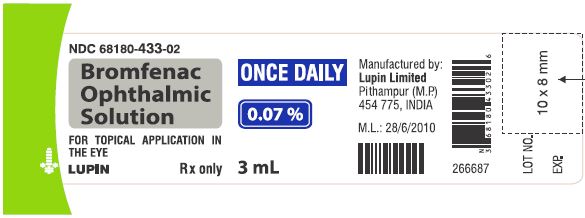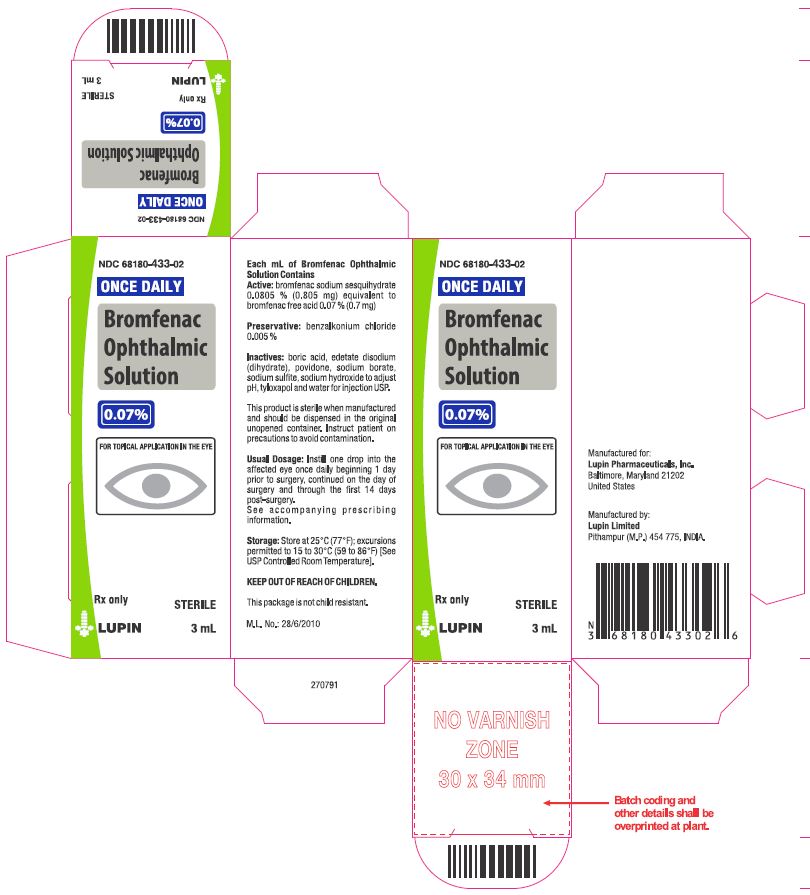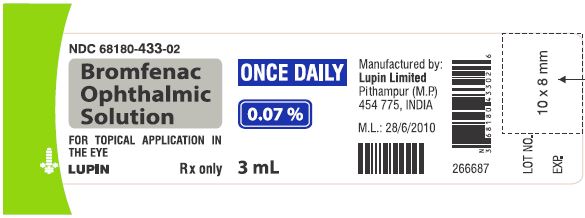Label: BROMFENAC SODIUM solution/ drops
- NDC Code(s): 68180-433-02
- Packager: Lupin Pharmaceuticals, Inc.
- Category: HUMAN PRESCRIPTION DRUG LABEL
- DEA Schedule: None
- Marketing Status: Abbreviated New Drug Application
Drug Label Information
Updated March 15, 2024
If you are a consumer or patient please visit this version.
- Download DRUG LABEL INFO: PDF XML
- Official Label (Printer Friendly)
-
HIGHLIGHTS OF PRESCRIBING INFORMATION
These highlights do not include all the information needed to use BROMFENAC OPHTHALMIC SOLUTION 0.07% safely and effectively.
See full prescribing information for BROMFENAC OPHTHALMIC SOLUTION.
BROMFENAC ophthalmic solution 0.07%
Initial U.S. Approval: 1997INDICATIONS AND USAGE
Bromfenac ophthalmic solution is a nonsteroidal anti-inflammatory drug (NSAID) indicated for the treatment of postoperative inflammation and reduction of ocular pain in patients who have undergone cataract surgery. (1)
DOSAGE AND ADMINISTRATION
Instill one drop into the affected eye once daily beginning 1 day prior to surgery, continued on the day of surgery, and through the first 14 days post-surgery. (2.1)
DOSAGE FORMS AND STRENGTHS
Topical ophthalmic solution: bromfenac 0.07 % (3)
CONTRAINDICATIONS
None (4)
WARNINGS AND PRECAUTIONS
ADVERSE REACTIONS
The most commonly reported adverse reactions in 3 to 8 % of patients were anterior chamber inflammation, foreign body sensation, eye pain, photophobia, and vision blurred. (6.1).
To report SUSPECTED ADVERSE REACTIONS, contact Lupin Pharmaceuticals, Inc. at 1-800-399-2561 or FDA at 1-800-FDA-1088 or www.fda.gov/medwatch
See 17 for PATIENT COUNSELING INFORMATION.
Revised: 3/2024
-
Table of Contents
FULL PRESCRIBING INFORMATION: CONTENTS*
1 INDICATIONS AND USAGE
2 DOSAGE AND ADMINISTRATION
2.1 Recommended Dosing
2.2 Use with Other Topical Ophthalmic Medications
3 DOSAGE FORMS AND STRENGTHS
4 CONTRAINDICATIONS
5 WARNINGS AND PRECAUTIONS
5.1 Sulfite Allergic Reactions
5.2 Slow or Delayed Healing
5.3 Potential for Cross-Sensitivity
5.4 Increased Bleeding Time
5.5 Keratitis and Corneal Reactions
5.6 Contact Lens Wear
6 ADVERSE REACTIONS
6.1 Clinical Trial Experience
8 USE IN SPECIFIC POPULATIONS
8.1 Pregnancy
8.3 Nursing Mothers
8.4 Pediatric Use
8.5 Geriatric Use
11 DESCRIPTION
12 CLINICAL PHARMACOLOGY
12.1 Mechanism of Action
12.3 Pharmacokinetics
13 NONCLINICAL TOXICOLOGY
13.1 Carcinogenesis, Mutagenesis, Impairment of Fertility
14 CLINICAL STUDIES
14.1 Ocular Inflammation and Pain
16 HOW SUPPLIED/STORAGE AND HANDLING
17 PATIENT COUNSELING INFORMATION
17.1 Slowed or Delayed Healing
17.2 Sterility of Dropper Tip
17.3 Concomitant Use of Contact Lenses
17.4 Concomitant Topical Ocular Therapy
- *
- Sections or subsections omitted from the full prescribing information are not listed.
- 1 INDICATIONS AND USAGE
-
2 DOSAGE AND ADMINISTRATION
2.1 Recommended Dosing
One drop of bromfenac ophthalmic solution should be applied to the affected eye once daily beginning 1 day prior to cataract surgery, continued on the day of surgery, and through the first 14 days of the postoperative period.
2.2 Use with Other Topical Ophthalmic Medications
Bromfenac ophthalmic solution may be administered in conjunction with other topical ophthalmic medications such as alpha-agonists, beta-blockers, carbonic anhydrase inhibitors, cycloplegics, and mydriatics. Drops should be administered at least 5 minutes apart.
- 3 DOSAGE FORMS AND STRENGTHS
- 4 CONTRAINDICATIONS
-
5 WARNINGS AND PRECAUTIONS
5.1 Sulfite Allergic Reactions
Contains sodium sulfite, a sulfite that may cause allergic type reactions including anaphylactic symptoms and life-threatening or less severe asthmatic episodes in certain susceptible people. The overall prevalence of sulfite sensitivity in the general population is unknown and probably low. Sulfite sensitivity is seen more frequently in asthmatic than in non-asthmatic people.
5.2 Slow or Delayed Healing
All topical nonsteroidal anti-inflammatory drugs (NSAIDs), including bromfenac, may slow or delay healing. Topical corticosteroids are also known to slow or delay healing. Concomitant use of topical NSAIDs and topical steroids may increase the potential for healing problems.
5.3 Potential for Cross-Sensitivity
There is the potential for cross-sensitivity to acetylsalicylic acid, phenylacetic acid derivatives, and other NSAIDs, including bromfenac. Therefore, caution should be used when treating individuals who have previously exhibited sensitivities to these drugs.
5.4 Increased Bleeding Time
With some NSAIDs, including bromfenac, there exists the potential for increased bleeding time due to interference with platelet aggregation. There have been reports that ocularly applied NSAIDs may cause increased bleeding of ocular tissues (including hyphemas) in conjunction with ocular surgery.
It is recommended that bromfenac ophthalmic solution be used with caution in patients with known bleeding tendencies or who are receiving other medications which may prolong bleeding time.
5.5 Keratitis and Corneal Reactions
Use of topical NSAIDs may result in keratitis. In some susceptible patients, continued use of topical NSAIDs may result in epithelial breakdown, corneal thinning, corneal erosion, corneal ulceration or corneal perforation. These events may be sight threatening. Patients with evidence of corneal epithelial breakdown should immediately discontinue use of topical NSAIDs, including bromfenac, and should be closely monitored for corneal health.
Post-marketing experience with topical NSAIDs suggests that patients with complicated ocular surgeries, corneal denervation, corneal epithelial defects, diabetes mellitus, ocular surface diseases (e.g., dry eye syndrome), rheumatoid arthritis, or repeat ocular surgeries within a short period of time may be at increased risk for corneal adverse events which may become sight threatening. Topical NSAIDs should be used with caution in these patients.
Post-marketing experience with topical NSAIDs also suggests that use more than 24 hours prior to surgery or use beyond 14 days post-surgery may increase patient risk for the occurrence and severity of corneal adverse events.
5.6 Contact Lens Wear
Bromfenac ophthalmic solution should not be instilled while wearing contact lenses. Remove contact lenses prior to instillation of bromfenac ophthalmic solution. The preservative in bromfenac ophthalmic solution, benzalkonium chloride may be absorbed by soft contact lenses. Lenses may be reinserted after 10 minutes following administration of bromfenac ophthalmic solution.
-
6 ADVERSE REACTIONS
6.1 Clinical Trial Experience
Because clinical trials are conducted under widely varying conditions, adverse reaction rates observed in the clinical trials of a drug cannot be directly compared to rates in the clinical trials of another drug and may not reflect the rates observed in clinical practice.
The most commonly reported adverse reactions following use of bromfenac ophthalmic solution following cataract surgery include: anterior chamber inflammation, foreign body sensation, eye pain, photophobia, and vision blurred. These reactions were reported in 3 to 8 % of patients.
-
8 USE IN SPECIFIC POPULATIONS
8.1 Pregnancy
Treatment of rats at oral doses up to 0.9 mg/kg/day (systemic exposure 90 times the systemic exposure predicted from the recommended human ophthalmic dose [RHOD] assuming the human systemic concentration is at the limit of quantification) and rabbits at oral doses up to 7.5 mg/kg/day (150 times the predicted human systemic exposure) produced no treatment-related malformations in reproduction studies. However, embryo-fetal lethality and maternal toxicity were produced in rats and rabbits at 0.9 mg/kg/day and 7.5 mg/kg/day, respectively. In rats, bromfenac treatment caused delayed parturition at 0.3 mg/kg/day (30 times the predicted human exposure), and caused dystocia, increased neonatal mortality and reduced postnatal growth at 0.9 mg/kg/day.
There are no adequate and well-controlled studies in pregnant women. Because animal reproduction studies are not always predictive of human response, this drug should be used during pregnancy only if the potential benefit justifies the potential risk to the fetus.
Because of the known effects of prostaglandin biosynthesis-inhibiting drugs on the fetal cardiovascular system (closure of ductus arteriosus), the use of bromfenac ophthalmic solution during late pregnancy should be avoided.
8.3 Nursing Mothers
Caution should be exercised when bromfenac ophthalmic solution is administered to a nursing woman.
-
11 DESCRIPTION
Bromfenac ophthalmic solution 0.07 % is a sterile, topical, nonsteroidal anti-inflammatory drug (NSAID) for ophthalmic use. Each mL of bromfenac ophthalmic solution contains 0.805 mg bromfenac sodium sesquihydrate (equivalent to 0.7 mg bromfenac free acid). The USAN name for bromfenac sodium sesquihydrate is bromfenac sodium. Bromfenac sodium is designated chemically as sodium [2-amino-3-(4-bromobenzoyl) phenyl] acetate sesquihydrate, with an molecular formula of C15H11BrNNaO3• 1½H2O. The chemical structure for bromfenac sodium sesquihydrate is:

Bromfenac sodium is a yellow to orange crystalline powder. The molecular weight of bromfenac sodium is 383.17. Bromfenac ophthalmic solution, 0.07 % is supplied as a sterile aqueous 0.07 % solution, with a pH of 7.55 to 8.15. The osmolality of bromfenac ophthalmic solution, 0.07 % is approximately 280 to 340 mOsmol/kg.
Each mL of bromfenac ophthalmic solution, 0.07 % contains:
Active: Each mL contains bromfenac sodium sesquihydrate 0.0805 %, which is equivalent to bromfenac free acid 0.07 %.
Preservative: benzalkonium chloride 0.005 %
Inactives: boric acid, edetate disodium (dihydrate), povidone, sodium borate, sodium sulfite, sodium hydroxide to adjust pH, tyloxapol and water for injection USP.
-
12 CLINICAL PHARMACOLOGY
12.1 Mechanism of Action
Bromfenac is a nonsteroidal anti-inflammatory drug (NSAID) that has anti-inflammatory activity. The mechanism of its action is thought to be due to its ability to block prostaglandin synthesis by inhibiting cyclooxygenase (COX) 1 and 2. Prostaglandins have been shown in many animal models to be mediators of certain kinds of intraocular inflammation. In studies performed in animal eyes, prostaglandins have been shown to produce disruption of the blood-aqueous humor barrier, vasodilation, increased vascular permeability, leukocytosis, and increased intraocular pressure.
12.3 Pharmacokinetics
The plasma concentration of bromfenac following ocular administration of 0.07 % bromfenac ophthalmic solution in humans is unknown. Based on the maximum proposed dose of one drop to each eye (0.035 mg) and PK information from other routes of administration, the systemic concentration of bromfenac is estimated to be below the limit of quantification (50 ng/mL) at steady-state in humans.
-
13 NONCLINICAL TOXICOLOGY
13.1 Carcinogenesis, Mutagenesis, Impairment of Fertility
Long-term carcinogenicity studies in rats and mice given oral doses of bromfenac up to 0.6 mg/kg/day (systemic exposure 30 times the systemic exposure predicted from the recommended human ophthalmic dose [RHOD] assuming the human systemic concentration is at the limit of quantification) and 5 mg/kg/day (340 times the predicted human systemic exposure), respectively, revealed no significant increases in tumor incidence.
Bromfenac did not show mutagenic potential in various mutagenicity studies, including the reverse mutation, chromosomal aberration, and micronucleus tests.
Bromfenac did not impair fertility when administered orally to male and female rats at doses up to 0.9 mg/kg/day and 0.3 mg/kg/day, respectively (systemic exposure 90 and 30 times the predicted human exposure, respectively).
-
14 CLINICAL STUDIES
14.1 Ocular Inflammation and Pain
Bromfenac 0.07 % QD for the treatment of postoperative inflammation and reduction of ocular pain was evaluated in two multi-center, randomized, double-masked, parallel-group and placebo (vehicle)-controlled studies. Patients undergoing cataract surgery self-administered bromfenac 0.07 % or vehicle once daily, beginning 1 day prior to surgery, continuing on the morning of surgery and for 14 days after surgery. Complete clearance of ocular inflammation (0 cell and no flare) was assessed on Days 1, 3, 8 and 15 post-surgery using slit lamp biomicroscopy. The pain score was self-reported. The primary efficacy endpoint was the proportion of subjects who had complete clearance of ocular inflammation by day 15. In the intent-to-treat analyses from both assessments, complete clearance at Day 8 and Day 15, bromfenac 0.07 % was superior to vehicle as shown in the following table.
Proportion of Subjects with Cleared Ocular Inflammation (0 cells and no flare)
Study
Visit
Bromfenac 0.07 %
Vehicle
Difference (%) (Asymptotic 95 % CI)
Study 1
At Day 8
27/112 (24.1%)
7/108 (6.5%)
17.6 (8.4, 26.8)
At Day 15
51/112 (45.5%)
14/108 (13.0%)
32.5 (21.4, 43.8)
Study 2
At Day 8
33/110 (30.0%)
14/110 (12.7%)
17.3 (6.7, 27.9)
At Day 15
50/110 (45.5%)
30/110 (27.3%)
18.2 (5.7, 30.7)
Proportion of Subjects who Were Pain Free
Study
Visit
Bromfenac 0.07%
Vehicle
Difference (%) (Asymptotic 95% CI)
Study 1
At Day 1
91/112 (81.3%)
47/108 (43.5%)
37.7 (25.9, 49.6)
Study 2
At Day 1
84/110 (76.4%)
61/110 (55.5%)
20.9 (8.7, 33.1)
-
16 HOW SUPPLIED/STORAGE AND HANDLING
Bromfenac Ophthalmic Solution, 0.07% is supplied in a white low density polyethylene bottle fitted with a white low density polyethylene nozzle and sealed with grey colored high density polyethylene cap with tamper-evident ring as follows:
- 1.6 mL in 5 mL bottle (NDC 68180-433-01)
- 3 mL in a 5 mL bottle (NDC 68180-433-02)
Store at 25°C (77°F); excursions permitted to 15 to 30°C (59 to 86°F) [See USP Controlled Room Temperature].
-
17 PATIENT COUNSELING INFORMATION
17.1 Slowed or Delayed Healing
Advise patients of the possibility that slow or delayed healing may occur while using NSAIDs.
17.2 Sterility of Dropper Tip
Advise patients to replace bottle cap after using and to not touch dropper tip to any surface, as this may contaminate the contents.
Advise patients that a single bottle of bromfenac ophthalmic solution be used to treat only one eye.
17.3 Concomitant Use of Contact Lenses
Advise patients to remove contact lenses prior to instillation of bromfenac ophthalmic solution. The preservative in bromfenac ophthalmic solution, benzalkonium chloride, may be absorbed by soft contact lenses. Lenses may be reinserted after 10 minutes following administration of bromfenac ophthalmic solution.
- SPL UNCLASSIFIED SECTION
- PACKAGE LABEL.PRINCIPAL DISPLAY PANEL
-
INGREDIENTS AND APPEARANCE
BROMFENAC SODIUM
bromfenac sodium solution/ dropsProduct Information Product Type HUMAN PRESCRIPTION DRUG Item Code (Source) NDC:68180-433 Route of Administration OPHTHALMIC Active Ingredient/Active Moiety Ingredient Name Basis of Strength Strength BROMFENAC SODIUM (UNII: 8ECV571Y37) (BROMFENAC - UNII:864P0921DW) BROMFENAC 0.805 mg in 1 mL Inactive Ingredients Ingredient Name Strength BENZALKONIUM CHLORIDE (UNII: F5UM2KM3W7) BORIC ACID (UNII: R57ZHV85D4) EDETATE DISODIUM (UNII: 7FLD91C86K) POVIDONE (UNII: FZ989GH94E) SODIUM BORATE (UNII: 91MBZ8H3QO) SODIUM HYDROXIDE (UNII: 55X04QC32I) SODIUM SULFITE (UNII: VTK01UQK3G) TYLOXAPOL (UNII: Y27PUL9H56) WATER (UNII: 059QF0KO0R) Packaging # Item Code Package Description Marketing Start Date Marketing End Date 1 NDC:68180-433-02 1 in 1 CARTON 01/08/2024 1 3 mL in 1 BOTTLE, DROPPER; Type 2: Prefilled Drug Delivery Device/System (syringe, patch, etc.) Marketing Information Marketing Category Application Number or Monograph Citation Marketing Start Date Marketing End Date ANDA ANDA206027 01/08/2024 Labeler - Lupin Pharmaceuticals, Inc. (089153071) Registrant - LUPIN LIMITED (675923163) Establishment Name Address ID/FEI Business Operations LUPIN LIMITED 863645527 MANUFACTURE(68180-433) , PACK(68180-433)




